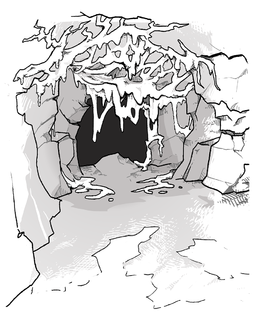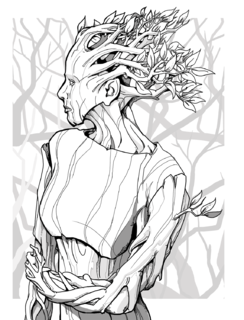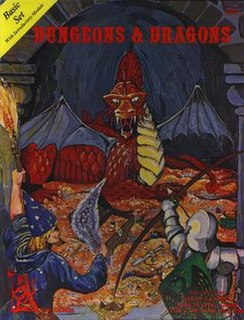A gelatinous cube is a fictional monster from the Dungeons & Dragons fantasy role-playing game. It is described as a ten-foot cube of transparent gelatinous ooze, which is able to absorb and digest organic matter.

In the Dungeons & Dragons roleplaying game, the locathah are a fictional fish-like humanoid race dwelling in warm coastal waters.
In the Dungeons & Dragons fantasy role-playing game, an ooze is a type of creature. This category includes such monsters as slimes, jellies, deadly puddings, and similar mindless, amorphous blobs. They can be used by Dungeon Masters as enemies of the player characters.
In Dungeons & Dragons, Fey is a category of creatures. The fey deities are associated with the Seelie Court and the Unseelie Court. Titania is the general fey deity, with individual races like the Killmoulis who worship Caoimhin. Fey are usually humanoid in form and generally have supernatural abilities and a connection to nature. The Sylph is one creature which has a Fey appearance, but is officially recognized as an outsider creature type.

In the Dungeons & Dragons fantasy role-playing game, the weretiger is a type of lycanthrope.

In the Dungeons & Dragons fantasy roleplaying game, the cockatrice is a small avian magical beast. Any creature that a cockatrice bites can be permanently turned to stone.

In the Dungeons & Dragons fantasy roleplaying game, merfolk are a race of humanoids that live underwater.

In Dungeons & Dragons, a lycanthrope is a humanoid shapeshifter based on various legends of lycanthropes, werecats, and other such beings. In addition to the werewolf, in Dungeons & Dragons, weretigers, wereboars, werebears and other shapeshifting creatures similar to werewolves and related beings are considered lycanthropes, although traditionally, "lycanthrope" refers to a wolf-human combination exclusively.

In the Dungeons & Dragons fantasy role-playing game, the roc is a gargantuan, eagle-like animal, based on an earlier creature from myth and fantasy also named the Roc.

In the Dungeons & Dragons fantasy role-playing game, the gray ooze is an ooze. It resembles a thick, viscous puddle of gray sludge, roughly 6 to 8 inches thick and up to 14 feet across, and often closely resembles wet stone or an amorphous rock formation.

In the Dungeons & Dragons fantasy role-playing game, green slime is an ooze, a category of monster. It is more akin to a plant than an animal. It is a horrible, fetid growth, resembling a bright green, sticky, wet moss which grows on the walls and ceilings of caves, sewers, dungeons, mines, and the like.

In the Dungeons & Dragons fantasy role-playing game, the dryad is a fey creature based upon the dryad of Greek mythology. They are tree spirits with the forms of beautiful women who benevolently protect forests and woodlands.

In the Dungeons & Dragons fantasy role-playing game, the werebear is a type of lycanthrope.

In the Dungeons & Dragons role-playing game, the groaning spirit is a type of undead. The creature is also known as the banshee.

In the Dungeons & Dragons fantasy role-playing game, the djinni is a type of genie.

In the Dungeons & Dragons fantasy role-playing game, the efreeti is a type of genie.
This is the Index of Advanced Dungeons & Dragons 1st edition monsters, an important element of that role-playing game. This list only includes monsters from official Advanced Dungeons & Dragons 1st Edition supplements published by TSR, Inc. or Wizards of the Coast, not licensed or unlicensed third party products such as video games or unlicensed Advanced Dungeons & Dragons 2nd Edition manuals.

In the Dungeons & Dragons fantasy role-playing game, the wereboar is a type of lycanthrope.

In the Dungeons & Dragons fantasy role-playing game, the werewolf is a type of lycanthrope.


















